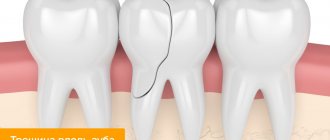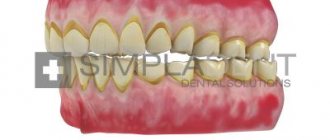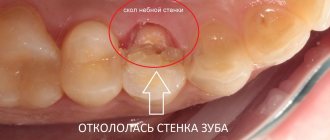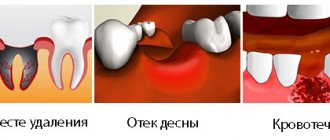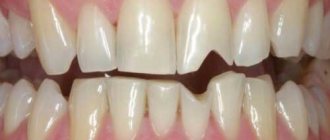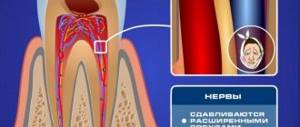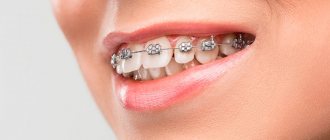Causes of loss of prosthetic structure
If a dental crown falls out, the first question patients usually ask is how this could happen and why. There are several reasons for this, and both the doctors who created and installed the product and the patients themselves may be to blame for the problem:
- low quality of materials and cement composition,
- violation of manufacturing techniques, non-compliance of the product with individual anatomical parameters: for example, the size of the prosthesis does not correspond to the stump (ground tip of the tooth), its height is incorrectly selected,
- mistakes made during the preparation of tooth tissue and preparation for prosthetics,
- development of an inflammatory process under the structure or at the border of its contact with the mucosa,
- the end of the service life of the product and the adhesive composition: if the crown falls out, then perhaps the patient wore it for too long, and the materials simply reached the end of their service life. Remember that different materials have their own service life. Thus, plastic lasts no more than 5 years, metal-ceramics - up to 10, and zirconium dioxide - from 15 years and longer,
- excessive pressure and increased chewing load on the denture: this can occur due to eating too hard foods or due to improper installation of the structure and not matching the patient’s bite parameters.
“Doctors attach permanent crowns to a cement composition, which retains its tightness for many years. And if during preparation for prosthetics, as well as at the stages of manufacturing and installation of the structure, everything is done correctly, then there should be no weakening of the fixation. If this happened, then perhaps the patient himself violated oral hygiene and did not follow the recommendations prescribed by the specialist,” says orthopedic dentist Dmitry Creamer.
It often happens that a temporary crown falls out. You need to understand that doctors are fixing it not with permanent, but with temporary cement. This situation can occur when the patient does not show up at the dentist’s appointment on time, but decides on his own initiative to walk with the installed structure longer than expected.
Important! Most often, orthopedic structures fall out due to poor quality prosthetics or insufficient preparation for treatment. To eliminate this point, contact only professional doctors and carefully choose the clinic where you will undergo dental restoration.
What symptoms accompany implant mobility?
There are two possible scenarios:
- there is no inflammation of the tissue around the implant, and it just wobbles, but does not hurt,
- the implant wobbles due to inflammation and pain in the jaw.
Of the possible complications, the first “scenario” is the least dangerous condition, which is most often caused by errors of the specialist installing the structure, and a number of diseases that affect the rate of osseointegration (diabetes mellitus, for example). In this case, the patient simply feels the mobility of the metal rod 2–3 weeks after the operation, the implant wobbles a little. The soft tissues around retain their former natural appearance, there is no pain or change in condition in the oral cavity. This is the most favorable outcome, allowing you to correct the situation with the least damage to your health and wallet.
However, the implant can also wobble due to poor-quality installation, as well as complete failure to engraft into the bone. This situation is not favorable - most likely, the product will have to be removed.
In the second case, mobility against the background of inflammation is a serious symptom that indicates rejection of the structure. And the instability of the structure, as a rule, occurs after the long-term existence of other signs of inflammation:
- the gums around the implant have changed color, become bright red, bluish, unevenly colored,
- there was slight swelling,
- the mucous membrane does not adhere tightly to the artificial structure, partially detaches from its surface,
- when chewing, pain occurs, as well as when touching the gums,
- bleeding gums around the implant,
- the appearance of a putrid odor from the area of the installed implant,
- discharge of pus from under the gums,
- body temperature remains elevated to 39°,
- there is a general malaise.
All these symptoms indicate developing mucositis or peri-implantitis - first superficial, and later deep inflammation of soft and bone tissues.
In both cases, you should not wait for the situation to improve; you should immediately seek professional help. Read more about the unfavorable outcome of implantation in the material “Dental implant rejection.”
In what cases are there chances to return the prosthesis to its place?
It must be emphasized that in most clinical cases, crowns fall out in such a way that they are then quite difficult to put back. Initially, they are “set” on a large amount of cement, which is almost impossible to remove thoroughly. After re-installation, the old structure will no longer fit tightly, it will not be able to exactly replicate the anatomy of the tooth, and food debris will begin to clog inside, which can cause inflammation. However, a fallen prosthesis can be returned to its place, and the likelihood of a favorable outcome will be higher in the following situations:
- if the crown has fallen out, and underneath there is a healthy tooth (stump), not affected by caries and other dental diseases,
- if the prosthesis is completely intact and relatively new (its service life has not expired): there are no chips, breaks or damage on it,
- if a temporary restoration falls out: it is attached to temporary cements, which are not difficult to remove.
In these cases, you need to quickly contact a dentist, who will correct the situation, in particular, clean the structure and tooth stump of cement and glue the prosthesis back, if possible. Remember that the prepared tooth is ground, depulped and very fragile, it is vulnerable to any mechanical stress, so the main task is to maintain its shape and prevent tissue destruction.
“A few months ago a crown fell out, but I had no time to go to the doctor, and money was tight, only our little girl was sent to kindergarten after maternity leave. I thought that I would have to spend money all over again, although both the prosthesis and the tooth underneath looked intact. While I was postponing the visit, my tooth was badly crumbled. When I came to the appointment, I was very upset that now I need to carry out the removal...”
Nellie, review from babyblog.ru
When it will be impossible to put the old denture back
1. If the prosthesis falls out along with the stump tab or pin
When a crown falls out along with a pin or stump insert, this may be a consequence of poor diagnostics (for example, when installing the pin, the doctor did not take into account that the walls of the roots are too thin) and preparation for prosthetics, de-cementation of the adhesive composition, and improper distribution of the chewing load.
Important! The stump tab and the pin are approximately equivalent in function, but according to numerous studies, the use of the tab is preferable, since the pin during operation can deform the root and even lead to necrosis of the adjacent tissues1.
Re-gluing fallen products is impossible in 90% of cases, because during the initial installation the doctor fixes both the inlay and the pin, as well as the crown itself, with cement. So, it will be very difficult to remove the remnants of glue and secure the old structures in place well. It is also worth emphasizing that the situation with a pin falling out is quite rare; more often it breaks in the root canals, and this leads to the need to remove the tooth.
If the prosthesis falls out with a stump insert or pin, then you need to consult a doctor as soon as possible to eliminate the possibility of developing an inflammatory process. The open area that remains after a pin or inlay falls out becomes vulnerable to various bacteria, pieces of food and liquids (saliva, drinks).
If retreatment and re-filling of root canals is required
Fixation may weaken due to the inflammatory process at the root. Then retreatment and cleaning of the canals will be required, and these are procedures that require tooth preparation and tissue grinding. And, accordingly, to accommodate the new parameters of the stump, a new orthopedic structure will have to be made that fits it in size.
In some cases, hard tissue after therapeutic manipulation may not be enough to install the old prosthesis, and the root will have to be additionally strengthened with a stump insert or pin. If it turns out that the walls of the root are thinned, damaged, significantly destroyed, or there is a crack on it, and this is what led to loosening and loss, then the tooth will have to be removed.
On a note! It will not be possible to install an old crown when re-treating a tooth, since for a high-quality result and to avoid repeated inflammation, it must fit tightly to its walls, and it will be impossible to achieve this after preparation.
If the structure falls out along with the root
Most often, this happens due to the inflammatory process and destruction of the supporting tooth itself, granuloma or cyst, or against the background of periodontal tissue diseases. With such a problem, the patient is left without a tooth, and he has to think about how to restore it further. This can be implantation, removable or bridge prosthetics.
Independent actions
If the pin falls out along with the crown, it can be restored in the clinic after a professional examination by dentists, if the structure was not destroyed. If the crown has fallen off at home, you can do the following yourself:
- If the crown is removed, the stump is cleared of the remaining cement mixture.
- The mouth is rinsed with a solution of Chlorhexidine or hydrogen peroxide.
- If the stump hurts, buy Analgin, Nimesil or Ibuprofen at the pharmacy for pain relief.
- The fallen structure is folded into a box and stored until an appointment with the doctor.
- Depending on the chosen composition, the structure is fixed for 15 days.
- The patient should avoid putting stress on the damaged tooth area.
Analgin
Nimesil
Ibuprofen
After a professional examination, the doctor will name the cause of the problem. If there were technological violations during the installation of the structure, then treatment or restoration of the pins is carried out free of charge.
The crown has fallen off the implant: can it be put back or not?
If the crown falls out of the implant, then in some situations it can be fixed back. Fixed dentures are attached to the implant using either dental cement or screws. If the structure was initially fixed with cement, it is impossible to reinstall it, since it is impossible to properly remove the remaining adhesive. If the fastening is screw, in almost 100% of cases you can return the crown to its place, but, of course, this must be done by a doctor.
In both situations, the implant itself does not need to be changed or removed if it is not loose, there are no signs of severe peri-implantitis and inflammation of the jaw bone tissue.
Surgical
It represents the complete removal of a cystic formation along with the damaged part of the root and crown or the complete removal of a tooth. The procedure is performed under local anesthesia.
Partial removal is carried out by splitting the crown into two halves. After which the infected part along with the cyst is eliminated. The resulting defect is closed with an artificial crown.
In some cases, resection of the gums and periosteum using the patchwork method is used. Next, the infected surface is cleaned, the purulent sac is removed and the wound is sutured.
General recommendations on what to do if a structure falls out
- carefully remove the denture from your mouth so as not to swallow it,
- disinfect and rinse your mouth thoroughly with an antiseptic,
- inspect the crown for damage, rinse with an antiseptic (in case it fell out while chewing food or fell on the floor). Place in a box or suitable box to prevent damage,
- take painkillers from your home medicine cabinet if necessary,
- make an appointment with your doctor as soon as possible.
Important! Until you have an appointment with the dentist, try not to chew on the side of the jaw where the denture fell out, and do not eat solid food. After all, now the defenseless tissues located under the structure are very vulnerable, and their destruction cannot be allowed - the chances of saving the tooth may decrease. After each meal, rinse your mouth thoroughly with antiseptics so that harmful bacteria that provoke an inflammatory process do not get into the ground stump or into open channels (if a pin or inlay has fallen out).
Solving a problem at home: what to glue it with and is it possible to do it?
If a crown falls out, many people search on the Internet for how to glue the product and how to fix it at home. To do this, some users advise using different means: superglue, chewing gum, Vaseline and toothpaste, cream for fixing removable dentures or specialized cement, which can be bought at the pharmacy.
Is it possible to insert fallen crowns yourself using the means listed above? You can't do this. Regular glue is toxic and can cause tissue inflammation; chewing gum will become an excellent source of food for bacteria in a short period of time.
Cream for removable dentures is a temporary solution that will help eliminate the problem for 1-2 days, but during this period there will be a risk that the structure will still come off (for example, the fixation of the composition may weaken due to drinking hot drinks) and you will not If you notice this, swallow it.
As for specialized cement, you must first carefully remove the remains of the old glue from the crown, but this is impossible to do at home (sometimes this is not possible even with specialized dental equipment, and then the structure must be replaced). If during installation the glue gets on the gum or, even worse, under the gum, and you cannot remove it, then inflammation cannot be avoided. Among other things, during manipulations you can damage the tooth stump or the prosthesis itself.
Even with the help of specialized cement, it is technically impossible to carry out the procedure correctly and safely at home, and there may be inflammation under the prosthesis or on the root that needs to be treated. Amateur action in this matter can lead to the need to remove the tooth later.
How can you strengthen a tooth if it suddenly starts to become loose?
First you need to determine the cause of mobility. If it is a pathology of the bite, for example, then orthodontic treatment will be mandatory. Teeth that are loose due to periodontal disease need to be restored comprehensively, using special materials to strengthen the gums.
Proper nutrition will help strengthen a loose tooth under a crown in the best possible way. You should definitely add to your diet:
- citrus;
- seafood;
- pumpkin seeds;
- fresh fruits and vegetables;
- dairy products;
- greenery;
- melons
Other products that contain vitamin A, which the body lacks, will also be useful - it is because of its lack that metabolism deteriorates and enamel deteriorates.
From pharmaceutical products, the following pastes, ointments and rinses can contribute to strengthening:
Options for solving problems in dentistry
The first option: the doctor returns the fallen product to its place using glue. Before this, the remains of old cement are removed from the structure, and the stump is treated with an antiseptic. In the case of an implant with a screw type of fastening, the prosthesis is re-fixed in place.
The second option: the specialist prepares the tooth for the creation of a new crown. This must be done if there was inflammation under the structure that needed to be treated (accordingly, the stump will then decrease in size and acquire new parameters). Or if the old structure cannot be thoroughly cleaned of glue, it is damaged or its service life has expired.
The third option: tooth extraction, preparation for subsequent implantation or bridge prosthetics. This is an extreme measure when the hard tissues and root are destroyed and cannot be restored.
Strengthening gums
How to strengthen teeth if they are swaying? In this case, the gum plays an important role, since the strength of the attachment of the tooth to the gum tissue depends on its health. There are a number of remedies that will help restore the functionality and health of your gums.
To strengthen, you can perform a massage that stimulates blood flow to the tissues. To do this you will need a small thin branch from a fruit tree. It must be chewed carefully. After 14 days, we use the second exercise to strengthen the gums: insert a stick between the front teeth and close the jaws, making slow movements, moving them in different directions from the right - left and forward - back. After 3-4 weeks of training, another exercise is added. Holding the tip of the branch in your teeth, carefully pull it with your hands.
You can use your own prepared rub. Twenty grams of honey, mixed with a teaspoon of table salt (burnt). The prepared rub is used to treat the gums, gently rubbing into the surface. To carry out the procedure, the prepared mixture is wrapped in calico fabric, and only then manipulation begins.

